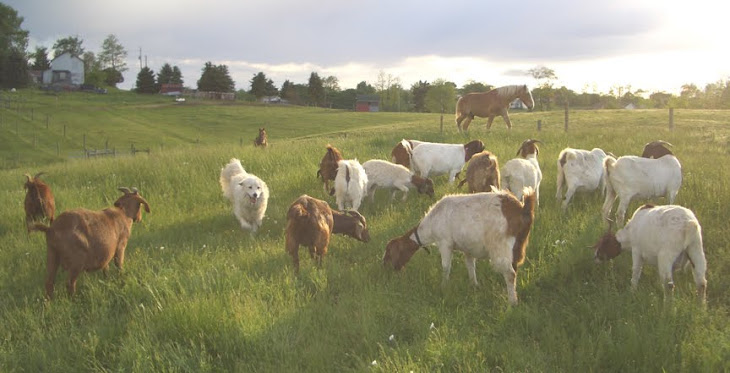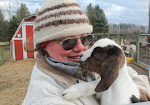 Yes, much to my residential neighbors' dismay. They would prefer it if the birds were sentenced to Alcatraz or the stew pot.
Yes, much to my residential neighbors' dismay. They would prefer it if the birds were sentenced to Alcatraz or the stew pot. I answer this question at least once a day, if not more, when I go to farmers markets. The next step is to educate the customer as to the differences between "free-range", "cage-free" and "pastured" as well as "natural" versus "Certified Organic".
 My birds are pastured and natural. That means they live outside, not fed commercial feed (I mix my own) or antibiotics and have not had their beaks trimmed. Yet there are people who prefer to pick up a dozen of Eggland's Best Certified Organic Cage-Free eggs for $0.22 less than mine from the local international conglomerate-owned grocery store because they feel they are getting a better deal since I'm not organic with a big O and a piece of paper. My hens also get to live when they molt instead of being ground up for fertilizer.
My birds are pastured and natural. That means they live outside, not fed commercial feed (I mix my own) or antibiotics and have not had their beaks trimmed. Yet there are people who prefer to pick up a dozen of Eggland's Best Certified Organic Cage-Free eggs for $0.22 less than mine from the local international conglomerate-owned grocery store because they feel they are getting a better deal since I'm not organic with a big O and a piece of paper. My hens also get to live when they molt instead of being ground up for fertilizer. "Do you have a rooster with your laying hens?"
When an customer asks this question, I'm 99% certain that if I tell them "no", they will exhale in a great sigh of relief and happily purchase a dozen eggs that have no potential to become embryos thanks to the instinct of a broody hen. {FYI--the roosters were only added again late last summer}
"I just don't want to be responsible for ending a life," they sometimes blurt out in an attempt to explain their ovo-vegetarian belief system. The truth is even when an egg is fertilized, if it is not incubated (by machine) or brooded (by hen), an embryo will not develop. Although I'm sure there are some politicians out there right now who would beg to differ....
But roosters exist for a reason, again, much to my neighbors' chagrin. Granted, it is a rather rude awakening for city folk turned country folk to realize that my big black and white cocks don't only crow at dawn, but in the middle of the afternoon and at night, particularly during a bright moon. Think of them more as watchdogs as it is their job to guard their ladies. Anyone keeping a flock of hens with a rooster will see soon enough that when the big boy makes a particular chirp, the ladies all scatter for cover. Look up and a hawk will be hovering. Or there's always the "come and get it" squawk when he discovers a mother lode of tasty treats. And of course, there's always the "hop on and wiggle" cackle. Where else do peeps come from? {and don't even say Tractor Supply!}
Welcome to the complete disconnect between the realities of raising food and eating food based upon misplaced ethical logistics or slick marketing.
As much as we'd like to press our ethnocentric ideals of feminism into the barnyard, the plain and simple truth is that males serve much more than a reproductive service in the animal kingdom. While there are squabbles and occasional sparring between the ladies {can you say 'pecking order'?}, those bad boys of the barnyard are equipped with thick leg spurs and an equally sharp attitude for a reason.
Here at the farm, I have two roosters--a purebred Barred Rock named Schtupp and Lucky, a Barred Rock/Auracanna cross with brilliant emerald iridescent feathers mixed in with his black and white plumage. He's aptly named because after buying several roosters from my organic feed guy for their colorful capes and saddles, an evening of skinning and cleaning left me tired, cold and hungry with one rooster left to go. I stuffed him in a cardboard box instead of a vacuum-sealed bag and took him home alive. There's plenty of hens to go around.....
And go around they do!
The one BIG disadvantage of free-ranging poultry that forage for bugs and such in the pastures is they also tend to lay there eggs in a variety of places so every day here at the farm is a Treasure Hunt despite having nesting boxes in the portable pen where there food is offered. Most of the spots are obvious, like inside the barn, under the gate between two stalls. That spot is good for about six to ten eggs a day. Sometimes if they can't get inside the barn, they'll lay then next to the ramp up to the center stall where the baby buck goats first go until they are big enough to handle a larger group. Under the canoe and in paddock #1's shelter are good for up to a dozen eggs each. The basement casement window well gets checked daily, too.
 But sometimes those biddies are outright stupid and will drop an egg any old place, including in the middle of a mud puddle. For the most part, though, they choose dark, enclosed spaces where there is some sort of nesting material--either straw, hay or leaves.
But sometimes those biddies are outright stupid and will drop an egg any old place, including in the middle of a mud puddle. For the most part, though, they choose dark, enclosed spaces where there is some sort of nesting material--either straw, hay or leaves. 
"Where do your chickens live in the winter?"
 Anyone concerned with poultry welfare and the quality of their eggs should be asking their farmer this question. During a visit to another farm that also sells "pastured eggs" at year-round markets, I was shocked to find all their laying hens stuffed into a room in their barn. No pasture, no dirt---just concrete, straw, crap and overcrowding. This way the light could be controlled and the hens would continue to lay. What most people don't understand about "natural" eggs, is that it is not natural for chickens to lay eggs year-round. Some, especially hybrids or very young layers will lay eggs over the winter months, for the most part, egg production is dictated by the amount of daylight.
Anyone concerned with poultry welfare and the quality of their eggs should be asking their farmer this question. During a visit to another farm that also sells "pastured eggs" at year-round markets, I was shocked to find all their laying hens stuffed into a room in their barn. No pasture, no dirt---just concrete, straw, crap and overcrowding. This way the light could be controlled and the hens would continue to lay. What most people don't understand about "natural" eggs, is that it is not natural for chickens to lay eggs year-round. Some, especially hybrids or very young layers will lay eggs over the winter months, for the most part, egg production is dictated by the amount of daylight. Consider the cost of those eggs when you realize the hens need to be fed even when they are not laying due to a lack of daylight or they are molting. That's why commercial layer operations have completely enclosed buildings so they can regulate the light tricking hens into believing a day is only eighteen hours long instead of twenty-four so they lay more or that they get rid of hens as soon as they molt for the first time--16-18 months. That's the life of a bird that lays eggs which sell for $1.29 a dozen. But look for those cheap egg prices to disappear as the cost of energy continues to rise; those industrial complexes are hydrocarbon-intensive operations, meaning they suck a lot of juice--electricity, natural gas and petroleum products and anyone who has filled any tanks lately wince at the growing costs.
 If you look closely at this image, you will see this flock of hens is on an area that will be planted this spring with vegetables. No petroleum-based fertilizers needed. No electricity or propane required to light the hen house. Similarly, Mother Nature designed those chickens with feathers. How many out there love your down/feather comforters, coats and sleeping bags...raise your hands. Nice and toasty, aren't they? The scratching isn't going to replace the rototiller, but the pigs' rooting will. It all works quite well together...it really does.
If you look closely at this image, you will see this flock of hens is on an area that will be planted this spring with vegetables. No petroleum-based fertilizers needed. No electricity or propane required to light the hen house. Similarly, Mother Nature designed those chickens with feathers. How many out there love your down/feather comforters, coats and sleeping bags...raise your hands. Nice and toasty, aren't they? The scratching isn't going to replace the rototiller, but the pigs' rooting will. It all works quite well together...it really does.







